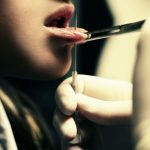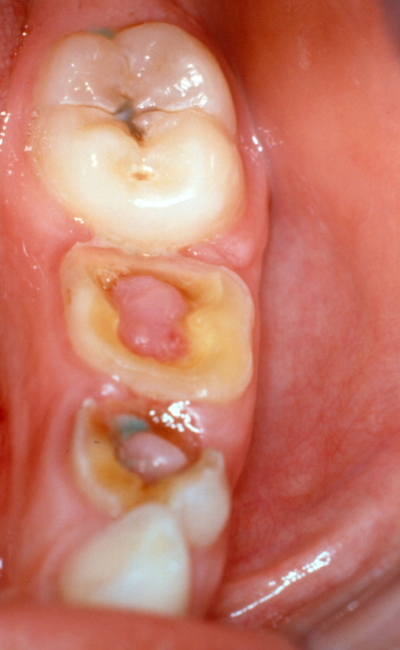You bite into an apple and then try to start talking to your friend about yesterday's math homework. Suddenly something feels funny — one of your baby teeth has fallen out! It's been loose forever, and now there it is, right in your hand. And you have an empty space in your mouth big enough to poke a drinking straw through. Before you put that tooth under your pillow, did you know that there is much more to that tooth than meets the eye? A single tooth has many different parts that make it work. And teeth play an important role in your daily life. They not only let you eat stuff like apples, they also help you talk. So let's talk teeth!
Tiny Teeth
Unlike your heart or brain, your teeth weren't ready to work from the day you were born. Although babies have the beginnings of their first teeth even before they are born, teeth don't become visible until babies are about 6 to 12 months old.
After that first tooth breaks through, more and more teeth begin to appear. Most kids have their first set of teeth by the time they are 3 years old. These are called the primary or baby teeth, and there are 20 in all. When a child gets to age 5 or 6, these teeth start falling out, one by one.
A primary tooth falls out because it is being pushed out of the way by the permanent tooth that is behind it. Slowly, the permanent teeth grow in and take the place of the primary teeth. By about age 12 or 13, most kids have lost all of their baby teeth and have a full set of permanent teeth.
There are 28 permanent teeth in all — eight more than the original set of baby teeth. Between the ages of 17 and 21, four more teeth called wisdom teeth usually grow in at the back of the mouth. They complete the adult set of 32 teeth.
Tooth Tour
Let's take a tour of your teeth. Look in the mirror at your own teeth or check out a friend's smile. The part of the tooth you can see, which is not covered by the gum (your gums are the pink, fleshy part), is called the crown. The crown of each tooth is covered with enamel (say: ih-nam-ul), which is very hard and often shiny. Enamel is a very tough substance and it acts as a tooth's personal bodyguard. Enamel works as a barrier, protecting the inside parts of the tooth.
 If you were able to peel away the enamel, you would find dentin (say: den-tin). Dentin makes up the largest part of the tooth. Although it is not as tough as enamel, it is also very hard.
If you were able to peel away the enamel, you would find dentin (say: den-tin). Dentin makes up the largest part of the tooth. Although it is not as tough as enamel, it is also very hard.
Dentin protects the innermost part of the tooth, called the pulp. The pulp is where each tooth's nerve endings and blood supply are found. When you eat hot soup, bite into a super-cold scoop of ice cream, fall and hurt a tooth, or get a cavity, it's your pulp that hurts. The nerve endings inside the pulp send messages to the brain about what's going on ("That ice cream is too cold!"). The pulp also contains the tooth's blood vessels, which feed the tooth and keep it alive and healthy.
The pulp goes all the way down into the root of the tooth, which is under the gum. Cementum (say: sih-men-tum) makes up the root of the tooth, which is anchored to the jawbone.
Tooth Types
You've probably noticed that you have different types of permanent teeth in your mouth. Each one has its own function.
Your two front teeth and the teeth on either side of them are incisors (say: in-sy-zurs). There are four on the top and four on bottom.
 Incisors are shaped like tiny chisels, with flat ends that are somewhat sharp. These teeth are used for cutting and chopping food. Think back to that apple you ate: You used your incisors to crunch into the skin of the apple.
Incisors are shaped like tiny chisels, with flat ends that are somewhat sharp. These teeth are used for cutting and chopping food. Think back to that apple you ate: You used your incisors to crunch into the skin of the apple.
The pointy teeth beside your incisors are called canine (say: kay-nine) teeth. There are four of them, two on top and two on bottom. Because these teeth are pointy and also sharp, they help tear food.
Next to your canine teeth are your premolars (say: pree-mo-lurs), which are also called bicuspid teeth. You have eight premolars in all, four on top and four on the bottom. You'll need to open a bit wider to see these teeth, but when you do, you'll notice that their shape is completely different from both incisors and canines. Premolars are bigger, stronger, and have ridges, which make them perfect for crushing and grinding food.
If you open your mouth really wide, you'll see your molars (say: mo-lurs). You have eight of these, four on the top and four on the bottom. Sometimes these are called your 6-year molars and your 12-year molars because that is around the time when they come in.
Molars are the toughest of the bunch. They are even wider and stronger than premolars, and they have more ridges. Molars work closely with your tongue to help you swallow food. How? The tongue sweeps chewed-up food to the back of your mouth, where the molars grind it until it's mashed up and ready to be swallowed.
As we mentioned earlier, the last teeth a person gets are wisdom teeth. These are also called third molars. They are all the way in the back of the mouth, one in each corner.
Wisdom teeth aren't used for anything and they are often removed because they can cause problems in a person's mouth. Some people believe that wisdom teeth may have been used by people millions of years ago to help them chew food. It's believed that they're called wisdom teeth because they come in later in life, when a young person is older and wiser.
Tooth Talk
Your teeth are great for chewing, but you also need them to talk. Different teeth work with your tongue and lips to help you form sounds. Try saying the word "tooth" slowly and notice how your tongue first hits the inside of your incisors to produce the hard "t" sound and then goes in between your upper and lower teeth to make the "th" sound.
And if you love to sing "la la la la la," you can thank those teeth every time you sing a song. Pay attention to what happens to your teeth and tongue every time you make the "l" sound.
Treating Teeth Kindly
Brushing your teeth with fluoride toothpaste is your best bet when it comes to keeping your teeth in tip-top shape. Try to brush after eating or at least twice a day. It's especially important to brush before bedtime.
The best way to brush your teeth is in little circles — go around and around until you have covered every surface of every tooth. Brush up and down, rather than side to side. You'll also want to clean between your teeth with dental floss (a special string for cleaning your teeth) at least once a day. That removes food and plaque (sticky stuff that can cause cavities or gum disease) that get stuck in between your teeth. You can also brush your tongue to help keep your breath fresh!
It's also important to visit your favorite tooth experts — your dentist and dental hygienist. During your appointment, they'll look out for any problems and clean and polish your teeth. Sometimes the dentist will take X-rays to get a better picture of what is going on in your mouth. You also might get a fluoride treatment while you're there.
In between dentist visits, you can prevent problems by eating fewer sugary snacks and sugary drinks, such as soda. Sugar can hurt your teeth and cause tooth decay, or cavities. But if you take care of your teeth now, you'll be chewing like a champ for the rest of your life!
 If you were able to peel away the enamel, you would find dentin (say: den-tin). Dentin makes up the largest part of the tooth. Although it is not as tough as enamel, it is also very hard.
If you were able to peel away the enamel, you would find dentin (say: den-tin). Dentin makes up the largest part of the tooth. Although it is not as tough as enamel, it is also very hard. Incisors are shaped like tiny chisels, with flat ends that are somewhat sharp. These teeth are used for cutting and chopping food. Think back to that apple you ate: You used your incisors to crunch into the skin of the apple.
Incisors are shaped like tiny chisels, with flat ends that are somewhat sharp. These teeth are used for cutting and chopping food. Think back to that apple you ate: You used your incisors to crunch into the skin of the apple.



 The first teeth you got were your baby teeth -- 20 in all, 10 on the top and 10 on the bottom. Baby teeth help you to talk and chew. But they also "save space" in your mouth so that there is room for your permanent teeth.
The first teeth you got were your baby teeth -- 20 in all, 10 on the top and 10 on the bottom. Baby teeth help you to talk and chew. But they also "save space" in your mouth so that there is room for your permanent teeth.  When all your permanent teeth have come in, you'll have 32 teeth all together. There will be 16 on the top, and 16 on the bottom. Out of these 32 teeth, 20 replace baby teeth, and the other 12 are new, permanent molars.
When all your permanent teeth have come in, you'll have 32 teeth all together. There will be 16 on the top, and 16 on the bottom. Out of these 32 teeth, 20 replace baby teeth, and the other 12 are new, permanent molars. 


 Causes:
Causes:







